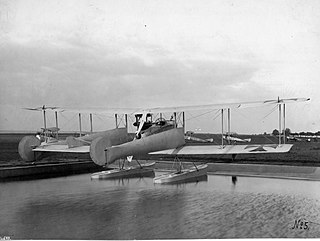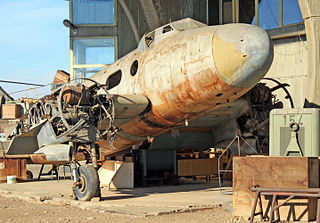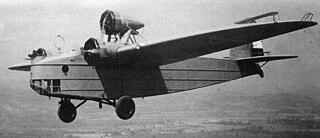
The PZL TS-8 Bies (Devil) is a Polish trainer aircraft, used from 1957 to the 1970s by the Polish Air Force and civilian aviation.

The Ikarus Aero 2 was a piston-engined military trainer aircraft built in Yugoslavia in the years following World War II, although the design pre-dated the war.

The Rogožarski IK-3 was a 1930s Yugoslav monoplane single-seat fighter, designed by Ljubomir Ilić, Kosta Sivčev and Slobodan Zrnić as a successor to the Ikarus IK-2 fighter. Its armament consisted of a hub-firing 20 mm (0.79 in) autocannon and two fuselage-mounted synchronised machine guns. It was considered comparable to foreign aircraft such as the Messerschmitt Bf 109E and came into service in 1940. The prototype crashed during testing; twelve production aircraft had been delivered by July 1940.

The Soko G-2 Galeb is a Yugoslav single engine, two-seater jet trainer and light ground-attack aircraft. The G-2 was developed during the 1950s by the Aeronautical Technical Institute at Žarkovo as a replacement for the Lockheed T-33 in service with the Yugoslav Air Force. Production started in 1965 at the Soko aircraft factory in Mostar, and ended in 1985 with 248 aircraft delivered. The G-2 had the distinction of being the first mass-produced jet aircraft in socialist Yugoslavia. It also served as a basis for the single-seat ground-attack J-21 Jastreb.

The Ikarus S-49 was a Yugoslav single-seat, single-engine fighter aircraft built for the Yugoslav Air Force shortly after World War II. Following the Tito–Stalin Split in 1948, the Yugoslav Air Force was left with an aircraft inventory consisting of mostly Soviet aircraft. Unable to acquire new aircraft or spare parts for its existing fleet, they turned to its domestic aviation industry in order to create an indigenous design to fulfill the need for additional aircraft.

The Gotha WD.3 was a prototype maritime reconnaissance floatplane developed during World War I by Gothaer Waggonfabrik (Gotha) for the Imperial German Navy's Naval Air Service. The three-seat aircraft used the pusher configuration with the engine behind the crew. It was lacking in performance compared to aircraft with the more common tractor configuration with the engine in the nose and was not approved for production. The single prototype completed was used as a training aircraft; its ultimate fate is unknown.

The Ikarus 214 was a military aircraft produced in Yugoslavia in the early 1950s. Originally intended as a light reconnaissance-bomber, it was produced as a trainer and transport aircraft when the testing of the prototype showed it had insufficient performance for the reconnaissance-bomber role.

The Ikarus 451 is a family of research aircraft designs built in Yugoslavia in the 1950s, all sharing the same basic airframe, but differing in powerplants and cockpit arrangements. One member of the family Ikarus 451M became the first domestically-built jet aircraft to fly in Yugoslavia, on 25 October 1952.

The Dornier Do Y was a trimotor German monoplane bomber of the early 1930s designed by Dornier Flugzeugwerke to an order by the Royal Yugoslav Air Force (RYAF). The Yugoslavs originally intended to use war reparations to pay for them, but ultimately had to use their own funds. Only a pair of aircraft were initially ordered to give the Yugoslavs experience with multi-engine bombers and Dornier failed to sell any more Do Y's. Two improved versions were subsequently built on speculation, but failed to find purchasers until the RYAF bought them in 1935.

The SIPA S.200 Minijet was a light sporting jet aircraft designed and produced by the French aircraft manufacturer Société Industrielle Pour l’Aéronautique (SIPA). It is designed to perform liaison, training, and aerobatic flights. The Minijet was claimed to be the first jet-powered light touring aircraft
The Zmaj R-1 was a twin-engined prototype bomber produced by Zmaj aircraft of the former Yugoslavia, designed in the 1930s. The aircraft remained a prototype due to a number of difficulties in testing.

The Ikarus Kurir is a single-engined high-wing monoplane designed in Yugoslavia for army liaison and air ambulance work from small airfields. Built in large numbers, it served with the Yugoslav Air Force (JRV) until 1972, when it entered civilian use.

The Bryan Autoplanes were a series of three experimental roadable aircraft.

The I.S.T. XL-15 Tagak was a single-engine, twin-boom, high-wing monoplane designed after the I.S.T. XL-14 Maya and built in the Philippines in the mid-1950s. The result of a collaboration between a Government research institute and the Philippine Air Force, it was designed as a utility, liaison or ambulance aircraft and as a test bed for the use of local materials in aviation.

The Rogožarski SIM-XIV-H was a 1930s Yugoslav coastal reconnaissance floatplane and light bomber, twin-engine, with three crew members. It was designed and built at the Rogožarski factory in Belgrade.
The Ikarus 215 twin-engine plane, was a Yugoslav light bomber and a training aircraft of mixed construction, the prototype flew in 1949. It did not go into production. The prototype was used for training and as a liaison. It was designed and built at the Ikarus factory in Zemun-Belgrade.
The Latécoère 225 was an unusual single seat canard microlight amphibian, with a swept wing, and of pusher configuration. It first flew in 1984 but was not put into production.
The Ikarus Orkan was a three-seat twin-engined monoplane designed as a light bomber/reconnaissance aircraft in the Kingdom of Yugoslavia before World War II. It was designed and built at the Ikarus factory in Zemun-Belgrade.
The Moscow Aviation Institute Sh-Tandem was a Soviet experimental ground attack aircraft of the 1930s. Designed by Peter Grushin at the Moscow Aviation Institute, the aeroplane featured an unusual tandem wing, with the tail planes as large as 45% of the wing area. Elevators served as ailerons at the same time. While similar in layout to contemporary Soviet fighters, the design also included a rear gunner's turret in the tail.

The SNCAC NC.1070 was a piston engined attack and torpedo bomber designed and built in France shortly after World War II. The second prototype, the NC1071, was the first French multi-jet turbine powered aircraft.














